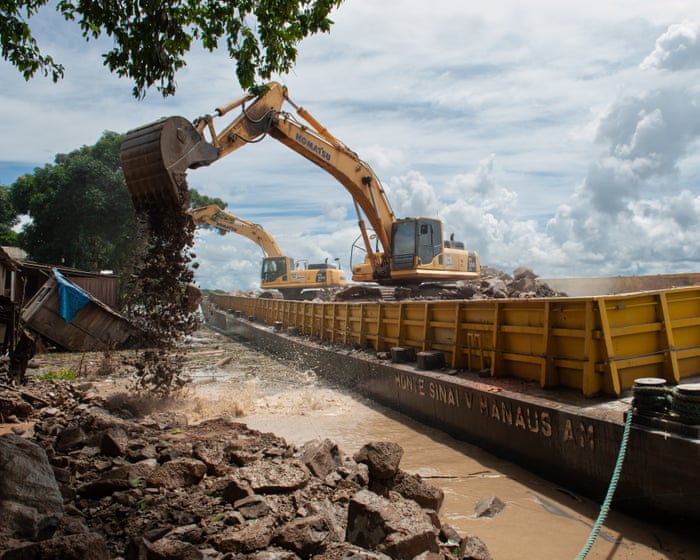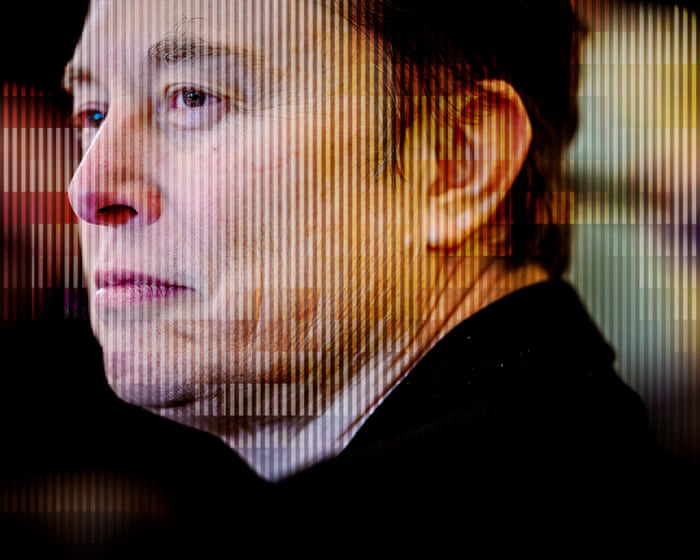In 2012, José Pereira do Nascimento lost his home after the Santo Antônio hydroelectric station in Porto Velho, located in Brazil’s northwest Amazon basin, opened its floodgates. The 3,568-megawatt plant, built to supply electricity for 45 million people, unleashed a muddy torrent that submerged his neighborhood, displacing 120 families.
“The river has gone wild. We used to know when it would flood and when it would dry up. Now nobody knows anymore,” says Nascimento, a rancher. “What people call progress has destroyed our history.”
His story is a sad one, but not unusual in the Amazon, where public works driven by political ambition and economic growth have replaced wilderness with boomtowns, highways, dams, and farms. While these projects have brought paved roads, electricity, and jobs, they have also caused disruption through chaotic urbanization, organized crime, rapid deforestation, and climate change.
A 2012 photo shows part of the Triângulo neighborhood in Porto Velho, flooded by water diverted from the Santo Antônio hydroelectric station.
Fueled by determined farmers and advanced crop science, the soybean industry has expanded deep into the Amazon, covering the land, filling silos, and helping Brazil become the world’s top exporter while boosting the country’s agribusiness-driven GDP.
Studies show that the transport of soybeans and corn in the “Amazon arc”—the infrastructure for moving crops—grew by 4.8% in the past year and by 288% over the last decade. As the agricultural belt expands, it is reshaping the Amazon’s environment, infrastructure, commerce, politics, and livelihoods.
Brazil is now one of the world’s most productive agricultural nations, thanks to harvests in the Cerrado, or central scrublands, and more recently in the Amazon biome. Soybeans are now grown in 25 of Brazil’s 27 states and cover over half of the country’s arable land, from the pampas to the equator.
Thirty years ago, only four of the nine Amazonian states cultivated soybeans. Today, all nine do, making the legume Brazil’s fastest-growing commodity. Mato Grosso, a vast state spanning the Cerrado and the Amazon, is the nation’s leading producer. In Rondônia, soybean cultivation has more than doubled since 2019, as has the local economy.
An aerial view of the Paulo Leal Community in Porto Velho shows it surrounded by vast soybean plantations encroaching on the village.
Under growing public pressure, traders and major soybean producers signed a “soy moratorium” in 2006, pledging not to buy or sell soybeans grown on Amazonian land deforested after 2008.
In 2023, the European Commission took it further, banning the sale of soybeans—and six other commodities—harvested from recently cleared Amazonian lands and requiring buyers to prove their imports were deforestation-free.
The good news for agribusiness is that these stricter rules haven’t reduced productivity. According to the latest report on the Amazon soybean moratorium, while 95.6% of the expansion occurred in areas already affected by human activity before 2008, 16% of the land used for soybeans in the Amazon was cleared after the ban. Cultivation in untouched forest nearly tripled from 2018 to 2023, reaching 250,000 hectares (620,000 acres).
A large field ready for harvest. Agricultural production from this region is mainly for export.
These figures have been contentious in Brazil—celebrated by large producers and condemned by environmentalists, who are preparing for Cop30, the critical UN climate conference in November.
“They invaded our land. But because we hadn’t built on our lot, they moved in, planted soybeans, and stayed,” says José Pereira do Nascimento.Amazonian growers, however, continued to complain that the soya moratorium was too restrictive and infringed on free enterprise. They argued that the rule prevented land clearing even in cases where Brazil’s 2012 forestry code allowed it—permitting Amazonian farms to deforest up to 20% of their property.
Last year, three Amazonian governors, led by Marcos Rocha of Rondônia, passed laws revoking tax incentives for those who signed the moratorium, claiming the agreement functioned like a soya cartel. This move was applauded by local farmers, many of whom had been penalized for clearing forest to plant crops.
Brazil’s anti-monopoly authority, Cade, agreed and suspended the moratorium on August 18, stating it unfairly favored a few large traders and farmers over medium and small-scale soya bean producers. However, a federal judge quickly overturned the antitrust board’s decision and reinstated the moratorium.
With the agricultural lobby gaining influence in Brasília, the dispute is far from resolved. Even if the moratorium remains in place, the rainforest and its inhabitants continue to face threats.
Nascimento—known as Zé Pereira to friends and family—has a firsthand view of the soya bean expansion. After moving between budget hotels for nearly a year, he settled in a small house 16 miles (25km) from Porto Velho. Though he isn’t at risk of losing another home, the 70-year-old retiree has watched with concern as the surrounding land is taken over by soya beans.
“They invaded our land,” says Nascimento. “Because we hadn’t built on our plot, they moved in, planted soya beans right up to the fence, and stayed.”
The cash crop now surrounds his neighborhood, has overrun a local cemetery, and stretches as far as the eye can see. On some days, the air is thick with clouds of herbicides and pesticides, which he can taste. He describes a tingling sensation in his face, followed by dizziness and difficulty breathing. “It’s not just me,” he adds. “Everyone here feels it.”
To the farmers, this is the smell of progress.
While most soya bean farmers are opportunists rather than villains in the destruction of the Amazon, the European Commission has identified strong indirect links between deforestation and soya cultivation. This is evident in Mato Grosso, where mechanized farms often take over depleted pastureland, pushing ranchers like Nascimento into untouched areas of neighboring Pará, in the eastern Amazon basin.
This pattern also drives up the price of forested land, based on the expectation of future profits once the trees are cleared—even though soya beans may not be planted until years later, as the European Commission noted.
Crucially, even if no more trees are cut down for farming, the expansion of soya bean plantations strengthens the lobby’s calls for improved infrastructure to store and transport their harvest to international markets. This has led to demands for more paved roads.To support the growing demands on the Amazon’s transport systems, rivers are being dredged, bridges and ports constructed, and railways laid to move larger cargoes. The BR-364 highway, a key link between western Amazonia and Atlantic ports, becomes paralyzed each harvest season.
Adélio Barofaldi, CEO of Rondônia-based logistics firm Rovema, reports, “We see 3,000 to 4,000 articulated soya trucks passing through Porto Velho daily, causing 200km of gridlock every day.”
In response to these bottlenecks, the federal government has privatized a section of the highway and plans to widen a crucial 60-mile stretch, known as the “Agro North route.”
This expansion comes at a cost to nature. Research indicates that almost 95% of deforestation in the Brazilian Amazon occurs within 3 miles of highways, while in the Colombian Amazon, 80% of forest loss happens within 5 miles of roads.
Road construction also leads to further development. A recent study on tropical highways found that each mile of an official “first-cut road” in the Amazon results in an additional 30 miles of secondary roads, with even greater deforestation occurring around these unofficial routes.
Sandro Dutra e Silva, an environmental historian at Goiás State University, warns that the success of soya in the Americas serves as a caution. “While tropical agriculture has been celebrated as a miracle that turned Brazil into an agricultural powerhouse,” he says, “the risk is that this technological achievement could blind people to the destruction of the Cerrado and Amazonia.”
He adds that overproduction in the savanna, which overlays vital South American aquifers, could disrupt water systems and climate patterns.
Alexandre Nepomuceno, head of soya bean research at Brazil’s Embrapa, which developed tropical soya varieties, argues against blaming scientific progress for policy failures. He believes the same innovation that expanded farming to the equator can help Amazonian farmers reduce their environmental impact.
For instance, Mariangela Hungria, a Brazilian soil microbiologist, won the 2025 World Food Prize for her work on bacteria that fix nitrogen from the air onto soya roots, nearly eliminating the need for expensive petroleum-based fertilizers. Last year, this biological fixation contributed to a record harvest, saved $25 million in fertilizer imports, and prevented 230 million tons of carbon emissions.
Nepomuceno emphasizes that while advanced research can guide sustainable practices, science alone cannot protect the Amazon. He asserts that policymakers, lawmakers, and authorities must establish and enforce regulations, noting, “Since Brazil already has ample deforested land, there is no need to clear more.”To grow soybeans.
Frequently Asked Questions
Of course Here is a list of FAQs about the global demand for soy and its impact on the Amazon with clear and concise answers
BeginnerLevel Questions The Basics
1 What does soy have to do with the Amazon rainforest
A huge amount of land in the Amazon is cleared to create space for soy farms This soy is then exported globally mainly for animal feed making it a major driver of deforestation
2 Why is the Amazon being cut down for soy
Because there is a massive and growing global demand for soy primarily to feed livestock like chickens pigs and cattle Brazil is one of the worlds largest soy producers and converting forest to farmland is seen as a way to meet this demand
3 Isnt soy used for things like tofu and soy milk
Yes but thats a small part of the story Over 7580 of all soy grown is processed into animal feed A much smaller percentage is used for direct human consumption and other products like biofuels
4 Why is losing the Amazon rainforest such a big deal
The Amazon is a critical carbon sink absorbing carbon dioxide that would otherwise heat the planet Destroying it accelerates climate change Its also home to immense biodiversity and regulates rainfall patterns across South America
IntermediateLevel Questions Digging Deeper
5 Are the soy farms in the Amazon legal
While there are laws against deforestation illegal clearing for agriculture is widespread and enforcement is challenging Furthermore legal loopholes and the sheer size of the region make it difficult to monitor all activity
6 What is the Soy Moratorium and did it work
The Soy Moratorium is an agreement by major soy traders not to buy soy from lands in the Amazon biome that were deforested after 2008 It has been largely successful in directly linking major soy companies to new deforestation but it has limitations and doesnt cover other critical ecosystems like the Cerrado savanna
7 Doesnt the soy industry create jobs and help Brazils economy
Yes it is a major export and a source of revenue However the longterm economic and environmental costs of deforestationsuch as disrupted rainfall loss of ecotourism and climate impactsare immense and often not accounted for




